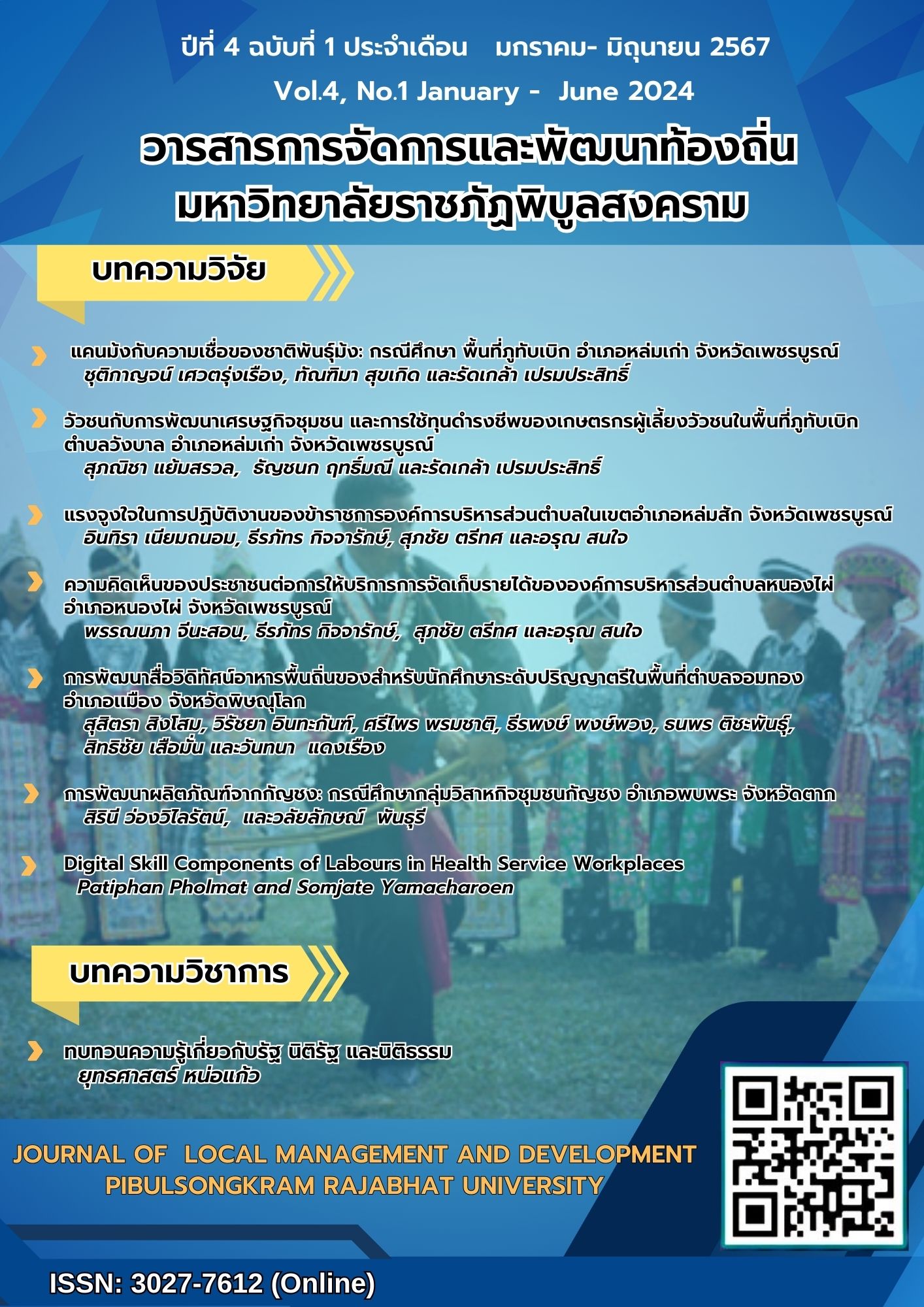Digital Skill Components of Labours in Health Service Workplaces
Keywords:
Digital skills, Labour, Health Service WorkplacesAbstract
This research aimed to study the digital skill components of labours in health service workplaces. Quantitative research method was employed. The sample group was 1,452 people who worked health service workplaces and had experience using the internet from micro data of the 2020 Household of Information Technology Use Survey project of the National Statistical Office. The data was collected using an interview form and was analyzed with descriptive statistics and exploratory factor analysis. The result found that labours in health service workplaces are mostly female, 82.6 percent. They were in the Generation Y age group, 44.8 percent (average age 39.5 years), had the status of head of the household, 39.7 percent, had a bachelor's degree, 72.2 percent, and almost one out of every three people, or 31.8 percent lived in the central region. In terms of work status, it was found that the majority of labours worked as professional nurses, 35.1 percent and worked in hospitals, 84.2percent. The digital skill components of labours in health service workplaces were determined to have eight components, including: government and health information access, computer usages for work, creating and downloading content, computer system management, working online with others, content management and networking, purchasing products and services, and finding jobs and studying online. All of these variables were able to account for 59.7 percent of digital skills of labours in health service workplaces.
References
Baudier, P., Kondrateva, G., Ammi, C., Chang, V., & Schiavone, F. (2023). Digital transformation of healthcare during the COVID-19 pandemic: Patients’ teleconsultation acceptance and trusting beliefs. Technovation. 120: 102547. doi: 10.1016/j.technovation.2022.102547.
Bunkhaeng, T. (2023). Health Information System Management for Policy Response of the district health service network in Phetchabun Province. Phetchabun Hospital Journal, 1(11), 1-16. (in Thai)
Chaker, R. (2020). Digital Skills Are Predictors of Professional Social Capital Through Workplace and Social Recognition. Italian Journal of Sociology of Education, 12(2), 23-50.
Chang J., & Huynh P. (2016). ASEAN in transformation: The future of jobs at risk of automation. Geneva: International Labour Office
EU Digital Skills and Jobs Coalition. (2022). Measuring digital skills across the EU: Digital skills indicator 2.0. Luxembourg: Publications Office of the European Union.
Fuchs, C., & Sevignani, S. (2013). What is digital labour? what is digital work? what’s their difference? and why do these questions matter for understanding social media? TripleC (Cognition, Communication, Co-Operation), 11, 237-293.
International Labour Organization. (2021). Changing demand for skills in digital economies and societies. Geneva: International Labour Organization.
Lowe, C. (2022). The digitalisation of social protection before and since the onset of Covid-19: Opportunities, challenges and lessons. London: ODI.
Mapong, K., et al. (2017). eHealth Strategy, Ministry of Public Health 2017 – 2026. Nonthaburi: ICT center, Office of Permanent Secretary. (in Thai)
Pradhan, B., & Pattanaik, P. (2020). Digital technology impacts on the labour market and the transport industry. Palarch’s Journal of Archaeology of Egyptology, 17(6), 5116-5124.
Savić, D. (2020). COVID-19 and work from home: digital transformation of the workforce. Grey Journal, 16. 101-104.
The National Statistical Office Thailand. (2020). Household survey on the use of information and communication technology. Bangkok: Ministry of Digital Economy and Society. (in Thai)
van Dijk, J. (2020). The digital divide. Cambridge: Polity.

Downloads
Published
Issue
Section
License
Copyright (c) 2024 Journal of Local Management and Development Pibulsongkram Rajabhat University

This work is licensed under a Creative Commons Attribution-NonCommercial-NoDerivatives 4.0 International License.
ประกาศเกี่ยวกับลิขสิทธิ์
- เนื้อหาและข้อมูลในบทความที่ลงพิมพ์กับวิทยาลัยการจัดการและพัฒนาท้องถิ่นถือเป็นข้อคิดเห็น และความรับผิดชอบของผู้เขียนบทความโดยตรงซึ่งกองบรรณาธิการวารสารไม่จำเป็นต้องเห็นด้วย หรือร่วมรับผิดชอบใด ๆ
- บทความ ข้อมูล เนื้อหา รูปภาพ ฯลฯ ที่ได้รับการตีพิมพ์ในวิทยาลัยการจัดการและพัฒนาท้องถิ่นถือเป็นลิขสิทธิ์ของวารสารวารสารวิทยาลัยการจัดการและพัฒนาท้องถิ่น หากบุคคลหรือหน่วยงานใดต้องการนำทั้งหมดหรือส่วนหนึ่ง ส่วนใดไปเผยแพร่ต่อหรือเพื่อการกระทำการใด ๆ จะต้องได้รับอนุญาตเป็นลายลักษณ์อักษรจากวิทยาลัยการจัดการและพัฒนาท้องถิ่นก่อนเท่านั้น





